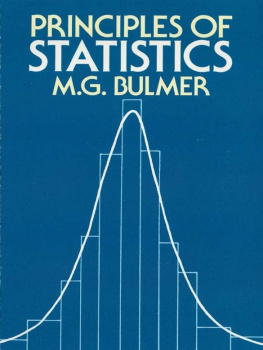Principles of Statistics
According to Unified Syllabus of B.Com. II Year
by
S.K. Shrivastava
V.K. Tripathi
M.Com. , Ph.D.
M.Com. , M.Phil. , Ph.D.
Professor, Department of Commerce Head, Department of Commerce Govt. Vijiya Raje Girls College, Kusum Bai Jain Girls College, Morar, Gwalior
Bhind
&
U.N. Singh
Priti Jain
M.Sc. , Ph.D. ( Statistics ) M.Com. , UGC-NET , Ph.D.
Associate Professor & Head, Department of Statistics Astt. Professor, Department of Applied Economics Raja Balvant Singh College, St. Aloysius' College (Autonomous), Bichpuri, Agra
Jabalpur
LATEST REVISED EDITION
RAM PRASAD PUBLICATIONS : AGRA-3
PREFACE
Unified Principles of Statistics is mostly regarded as a difficult subject but we are sure that this book is going to be of immense help to the students as beyond comprehensive because it has been written in simple language and its most systematic order explaining each and every point at length. Some of the special features of this book are : F
This book has been prepared for B.Com. students as per the prescribed latest syllabus.
F
Several illustrations and practical questions has been selected from various universities examination.
F
Hints will be found for difficult problems to enable students to work hard to complete problems.
F
Selection of illustrations and practical problems in each chapter has been placed in simple to complex form. It will be helpful to the weaker students.
F
A number of questions have been classified into various segments, as objective type questions and short answer type questions.
Our thanks are due to all those who took care to point out shortcomings or an error in this book.
We are grateful to, Ram Prasad Publications who has given valuable suggestions to improve the book.
We are sure that this book will serve the purpose of those persons who are interested in this subject, valuable suggestions are invited from the learned teachers and readers.
Authors
[ 3 ]
Contents Chapters
Pages
Unified Principles of Statistics UNIT-I
STATISTICS
....
....
STATISTICAL INVESTIGATION
....
....
1116
PROCESS OF DATA COLLECTION
....
....
1728
METHODS OF SAMPLING
....
....
2942
CLASSIFICATION & TABULATION OF DATA
....
....
4352
PREPARATION OF STATISTICAL SERIES AND ITS TYPES
....
....
5362
UNIT-II
MEASURES OF CENTRAL TENDENCY
....
....
63146
UNIT-III
MEASURES OF DISPERSION
....
....
147194
SKEWNESS
....
....
195216
ANALYSIS OF TIME SERIES
....
....
217246
UNIT-IV
CORRELATION ANALYSIS
....
....
247292
REGRESSION ANALYSIS
....
....
293324
UNIT-V
INDEX NUMBER
....
....
325370
DIAGRAMMATIC AND GRAPHIC REPRESENTATION OF DATA
....
371428
APPENDIX
....
....
LOG, ANTILOG, RECIPROCAL, TABLES AND THEIR USE
[ 7 ]
Document Outline
Statistics
Meaning, Definitions, Scope, Nature, Functions and Importance of
Statistics
Limitations of Statistics
Origin of Statistics
The word Statistics has been used in our daily life for so many years. In the early years kings and Emperors used to get the informations about population and economics for smooth running of administrations and political activities. So it was considered as the science of kings in the beginning.
It seems the English word Statistics has been derived from the latin word Status or the Italian word Statista. Both mean a political state.
For the first time Baron J.F. Von Bielfield wrote in his book entitled the Element of universal Erudition that Statistics is the science that teaches us about the political arrangement of all the modem states of the known world one can get the same type of informations from Kautilyas Arthashastra. In the ancient India the data of births and deaths were collected in Maurya kingdom. Same type of informations may be also seen in the old history of some other countries. Statistics, thus, was considered as a branch of economics in our old time.
The German Scientist Gottfried Acknewall introduced statistics first time in its present scientific form. Therefore he is known as father of statistics. The contribution of statisticians like Francis Galton, Dr. A.L. Bowley, Karl Pearson, William S. Gosset, R.A. Fisher, Professor Yule and Kendal and P.C. Mahelonobis are of great importance in the development of statistics.
Definitions of Statistics
The English word statistics is used in the three senses :
(1) Stastistics as the numerical figures or data. (2) Statistics as a science (as a subject)
(3) Statistics as measures based on samples.
The meanings first and second are related with the general purpose of statistics while the third meaning is related with research. The dictionary meaning of statistics is that it referes in the singular to the subject as a whole and in plural to the numerical data.
Here the definition of statistics is being given in the form of science of statistics (as a subject).
Statistics as a Subject : Statistics as a subject means Statistical methods. The reason behind it is that we can draw inferences of this analysing and explaining the data by statistical methods. There have been many definitions of the term statistics. We can divide them in two categories :
(1) Narrow Definitions (2) Extensive Definitions
(1) Narrow definition : The definition of this type given by different authors are mostly incomplete they emphasised only on some of the aspects of statistics.
Prof. A.L. Bowley has given three definitions :
(i) Statistics is the science of counting.
(ii) Statistics may rightly be called the science of averages.
(iii) Statistics is the science of the measurement of social organism, regarded as a whole in all its manifestations.
All the above definitions given by Bowley are incomplete. The first definition is too narrow. It covers only one aspect of statistical methods namely collection of data. Other aspects like analysis, tabulation, representation and interpretation have been completely ignored. In the second definition emphasis is given only to one device (average) used in statistical methods. The other devices like dispersion, coefficient of skewness, correlation coefficient are nor covered.
The comparison cannot be done only on the basis of averages. In third definition Bowley has confined the scope of statistics only to man and his social activities. The use of statistics cannot be confmed to only sociology. It can be used in natural science. Besides, only one device of statistics is measuring is used in this definition. Other devices are not mentioned here.
According to Boddington, Statistics is the science of estimates and probabilities. Here Boddington has empharised only two devices of Statistical methods estimate and probability. He has ignored the other devices. Therefore, this definition is also incomplete.
(2) Extensive definition : The definitions of statistics of this category cover all the devices of statistical methods. Some important definition out of them are as follows :










